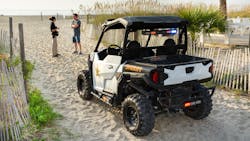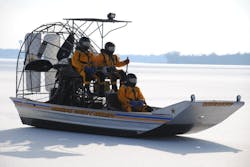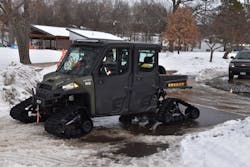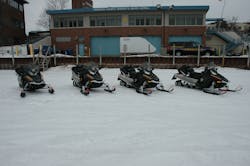When patrolling the streets, speed may be the key, but what about patrolling different areas such as in and around lakes, swamps and trails? In those environments, versatility and mobility take priority. Alternative vehicles provide a solution for many law enforcement agencies and continue to grow in popularity.
Lt. Shane Magnuson with the Hennepin County Sheriff’s Office Water Patrol Unit in Minnesota says that the agency, which assists with patrols in downtown Minneapolis while also patrolling Lake Minnetonka and rural areas of the county, must take into account the differing terrain. “We can have protests in downtown Minneapolis and then have to respond to a missing person in a park on the rural west side of Hennepin County. We just had a missing kid in the river. We literally go from the protest, and we’re shuffling resources up there to do that,” he says. “Our mission can change very quickly.”
The Water Patrol currently has six Polaris Ranger Utility Terrain Vehicles (UTVs), two Polaris Sportsman 570 All Terrain Vehicles (ATVs), two American Airboats, and eight Polaris 550 Fan Cooled Snowmobiles along with the unit’s ten boats and its standard patrol vehicles. All of the alternative vehicles used by the Hennepin County Sheriff’s Office serve a purpose while on patrol or responding to a major event.
On a Saturday morning in February, the agency responded to a small four-seat plane crash that left the pilot dead. The crash occurred in a swamp in a remote location in the area of the Crow-Hassan Park Reserve in the northwestern part of the county. The Hennepin County Sheriff’s Office used UTVs as well as snowmobiles. The agency had just recently purchased an additional four-door Ranger UTV. “Their application (UTVs) for that, they are so usable. You’ve got the bed; we were able to transport crime scene people and the medical examiner. Unlike a snowmobile where as far as capacity and passengers you are much more restricted.”
Patrol on the water
Traditional boats can be used to patrol most bodies of water, but when that water is extremely shallow—or frozen—agencies must find another way to get around. In South Florida, the Miami-Dade Police Department Hammocks District’s Agricultural Patrol Section has long faced a serious problem when it comes to patrolling 900 square miles of land dotted with hunting camps and in the flight path for multiple airports that are surrounded by the wetlands. Gaining access to the land through the shallow marshes and swamps was once only possible by helicopter and was both a drain on resources as well as time consuming.
After consulting with other agencies that already operated the vessels, the department purchased a 20-foot long by 8-foot wide Panther Airboat, which cost $75,000 and was paid for with funds primarily from the department’s Law Enforcement Trust Fund instead of taxpayer dollars. Zahalka says the boat will help save time during life and death situations.
The airboat allows the Miami-Dade Police Department to access those areas for search, rescue and recovery operations. These types of operations are typically conducted by multiple agencies, which include Miami-Dade Fire Rescue, Florida Fish and Wildlife Commission, and in some cases, Everglades National Park. “Having a good working relationship with these agencies and conducting joint patrols and training help prepare for major incidents,” says Zahalka. The airboat is also being used to combat illegal dumping and animal cruelty on the water.
The airboat is designed to comfortably carry eight full- size adults, and in the event of having to transport large pieces of equipment, such as an ATV, the front row of seats can be removed and the grass rake drops for easy loading. It is powered by a General Motors 6.2 Liter supercharged engine by Levitator Performance Airboat Engines. The engine produces approximately 550 horse power, which is connected to a belt drive system that spins a four-bladed 82-inch carbon fiber propeller.
Magnuson says that while Hennepin County’s airboats are mainly used during the Spring and Fall, they do use them in the winter too. Lake Minnetonka, which is a popular recreational and fishing lake, is broken up into different bays which go under bridges to create channels that can remain open year round. “With the airboats we don’t have to worry—unlike with an ATV or snowmobile—about falling through the ice,” he says. “We’re able to cross those channels and get from bay to bay to be able to do our job in the winter. We also use the airboats to mark the channels as open water or unsafe ice.”
Patrol on the snow
Since Minnesota gets its share of snow in the winter months, Hennepin County has to be prepared to respond, no matter how treacherous the conditions are. While the agency has both airboats for the ice and snowmobiles for the ice and snow, Magnuson said that the Polaris UTVs outfitted with tracks have proven to be one of the best options for cold weather.
Last winter, Polaris allowed the Sheriff’s Office to use three XP UTVs at the Lake Minnetonka Klondike Dog Derby. Magnuson says there were about five to six thousand people on the ice for the dog sled race.
He says that the UTVs serve multiple purposes and have become a fixture of the unit since it received its first less than a decade ago. “Even in an urban environment—we use them for large-scale protests and even parades—it’s much easier to get UTVs through crowded areas and across sidewalks than squad cars. You’re also much more approachable and it’s easier to talk to people than in a car, but you are still as mobile as you would be in a vehicle.”
Since the purchase of its first UTV about 8 years ago to the purchase of its most recent earlier this year, Magnuson says that there have been a lot of changes made in both technology and comfort. “The advancements in them are absolutely incredible over the past few years,” he says. “They sit a little bit higher, which isn’t as big of a deal, but the suspension while crossing ditches, they are a lot more controllable, they just drive better. It’s a lot like driving a really old car versus a newer car. The suspension and handling have just become remarkably better.”
He noted that the newer models come with more “creature comforts,” allowing deputies to focus on the job at hand during long shifts. “If you are spending 10 or 12 hours in a vehicle, having a good heating and cooling system is really nice,” he says. “The layout Polaris has included in the police package now comes equipped with emergency lights and siren, so we don’t have other vendors tapping into those wire systems. They more you add on after market, you can certainly have issues. Now that we can directly order all of that done from Polaris is a huge advantage.”
About the Author
Paul Peluso
Editor
Paul Peluso is the Managing Editor of OFFICER Magazine and has been with the Officer Media Group since 2006. He began as an Associate Editor, writing and editing content for Officer.com. Previously, Paul worked as a reporter for several newspapers in the suburbs of Baltimore, MD.






